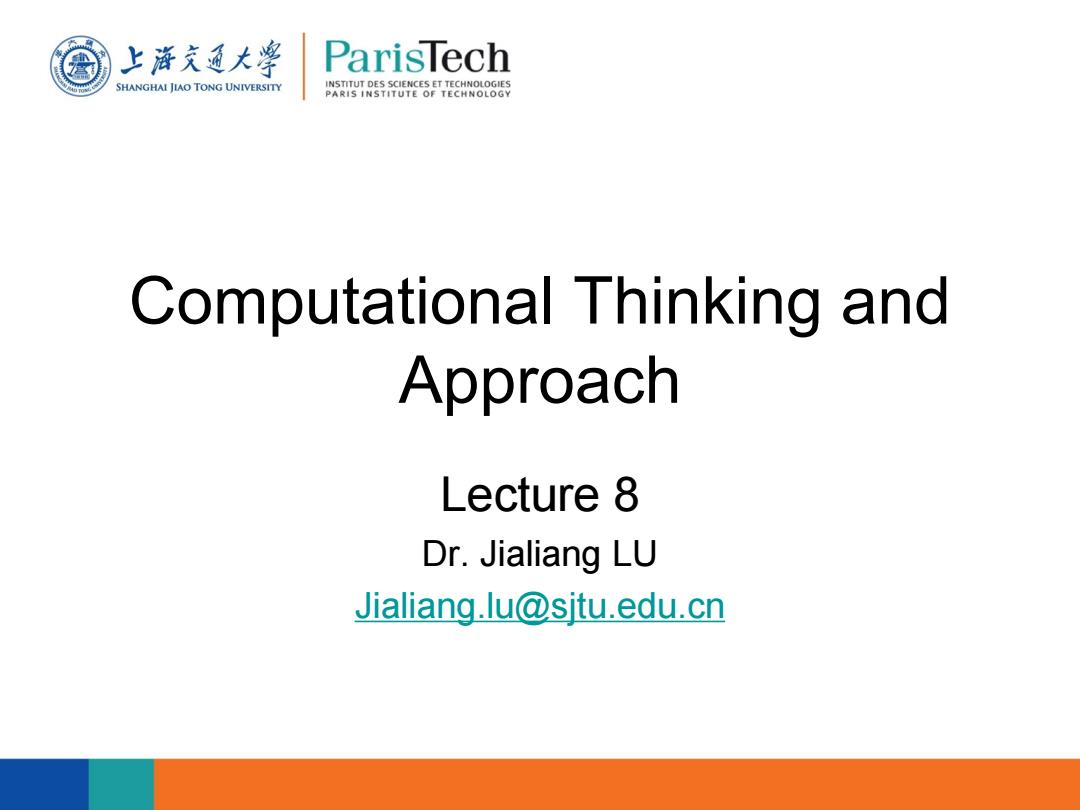
上游充通大 ParisTech SHANGHAI JIAO TONG UNIVERSITY INSTITUT DES SCIENCES ET TECHNOLOGIES PARIS INSTITUTE OF TECHNOLOGY Computational Thinking and Approach Lecture 8 Dr.Jialiang LU Jialiang.lu@situ.edu.cn
Computational Thinking and Approach Lecture 8 Dr. Jialiang LU Jialiang.lu@sjtu.edu.cn
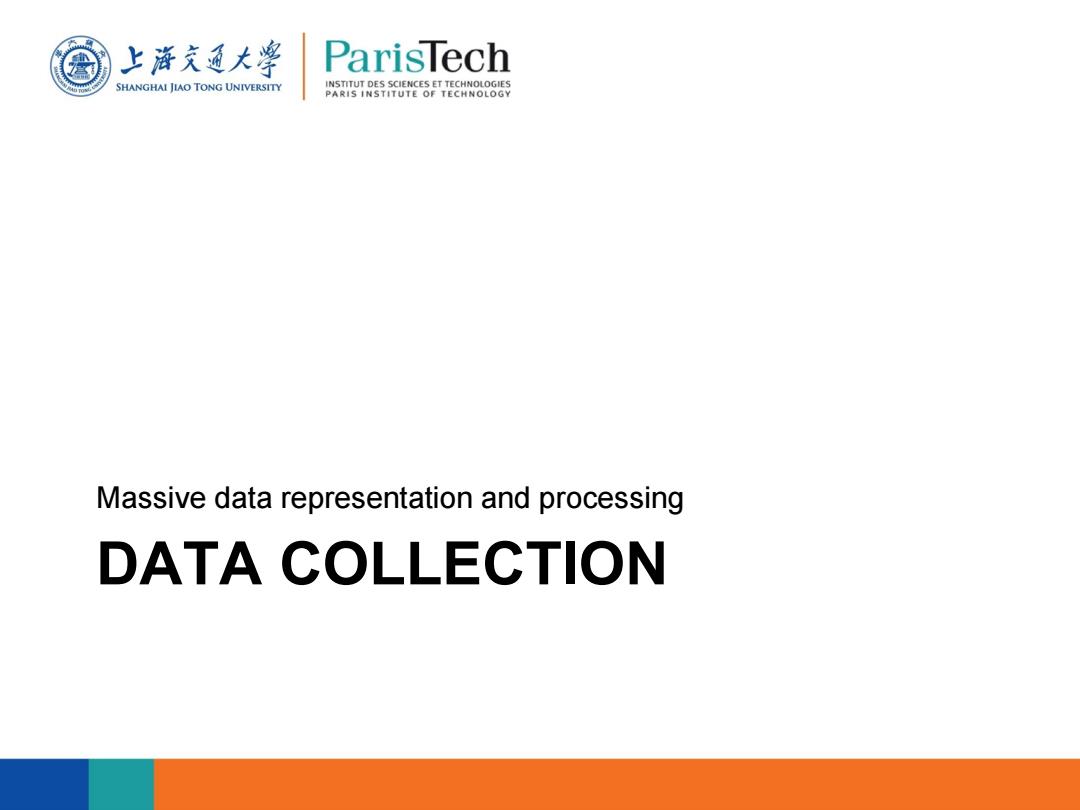
上游充通大 ParisTech SHANGHAI JIAO TONG UNIVERSITY INSTITUT DES SCIENCES ET TECHNOLOGIES PARIS INSTITUTE OF TECHNOLOGY Massive data representation and processing DATA COLLECTION
DATA COLLECTION Massive data representation and processing
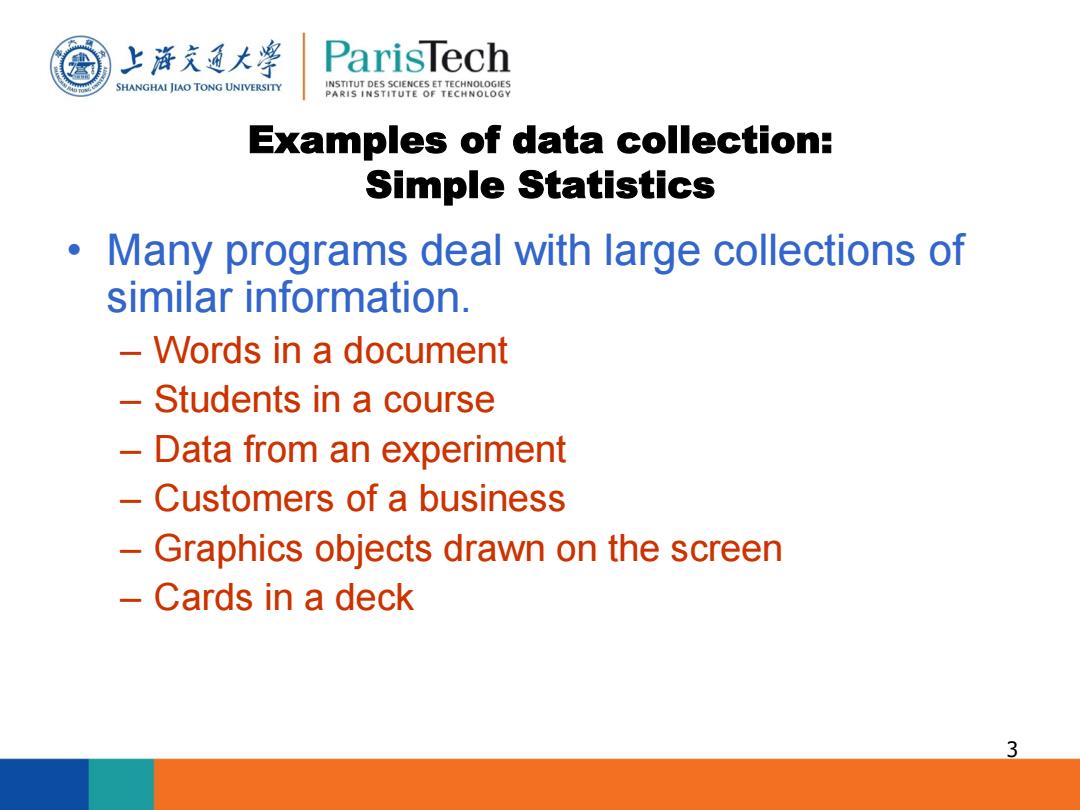
上游充通大 ParisTech SHANGHAI JIAO TONG UNIVERSITY INSTITUT DES SCIENCES ET TECHNOLOGIES PARIS INSTITUTE OF TECHNOLOGY Examples of data collection: Simple Statistics 。 Many programs deal with large collections of similar information. Words in a document Students in a course Data from an experiment Customers of a business Graphics objects drawn on the screen Cards in a deck 3
Examples of data collection: Simple Statistics • Many programs deal with large collections of similar information. – Words in a document – Students in a course – Data from an experiment – Customers of a business – Graphics objects drawn on the screen – Cards in a deck 3

上游充通大粤 ParisTech SHANGHAI JIAO TONG UNIVERSITY INSTITUT DES SCIENCES ET TECHNOLOGIES PARIS INSTITUTE OF TECHNOLOGY Sample Problem: Simple Statistics Let's review our code of average: average4.py 井 A program to average a set of numbers # Illustrates sentinel loop using empty string as sentinel def main(): sum 0.0 count =0 xStr raw input ("Enter a number (to quit)>>" while xStr!="": x eval(xStr) sumsum x count count 1 xStr raw input ("Enter a number (to quit)>>" print "\nThe average of the numbers is",sum count main ( 4
Sample Problem: Simple Statistics Let‟s review our code of average: # average4.py # A program to average a set of numbers # Illustrates sentinel loop using empty string as sentinel def main(): sum = 0.0 count = 0 xStr = raw_input("Enter a number ( to quit) >> ") while xStr != "": x = eval(xStr) sum = sum + x count = count + 1 xStr = raw_input("Enter a number ( to quit) >> ") print "\nThe average of the numbers is", sum / count main() 4
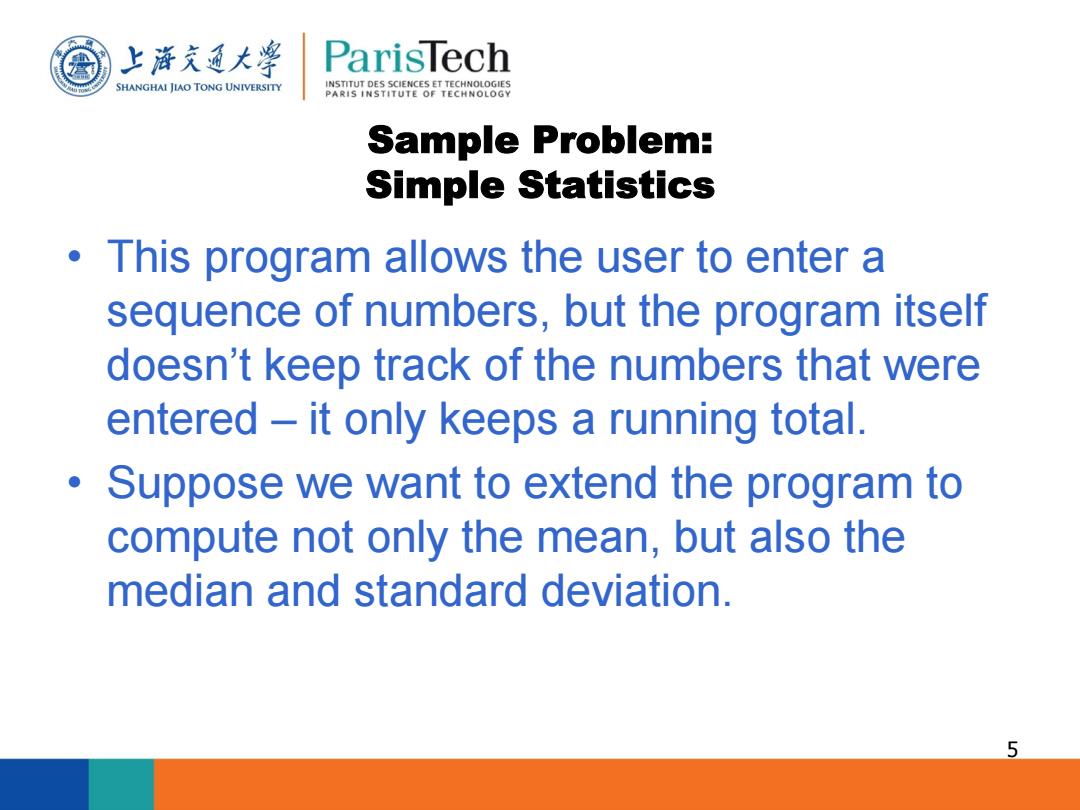
上游充通大 ParisTech SHANGHAI JIAO TONG UNIVERSITY INSTITUT DES SCIENCES ET TECHNOLOGIES PARIS INSTITUTE OF TECHNOLOGY Sample Problem: Simple Statistics This program allows the user to enter a sequence of numbers,but the program itself doesn't keep track of the numbers that were entered it only keeps a running total. Suppose we want to extend the program to compute not only the mean,but also the median and standard deviation. 5
Sample Problem: Simple Statistics • This program allows the user to enter a sequence of numbers, but the program itself doesn‟t keep track of the numbers that were entered – it only keeps a running total. • Suppose we want to extend the program to compute not only the mean, but also the median and standard deviation. 5
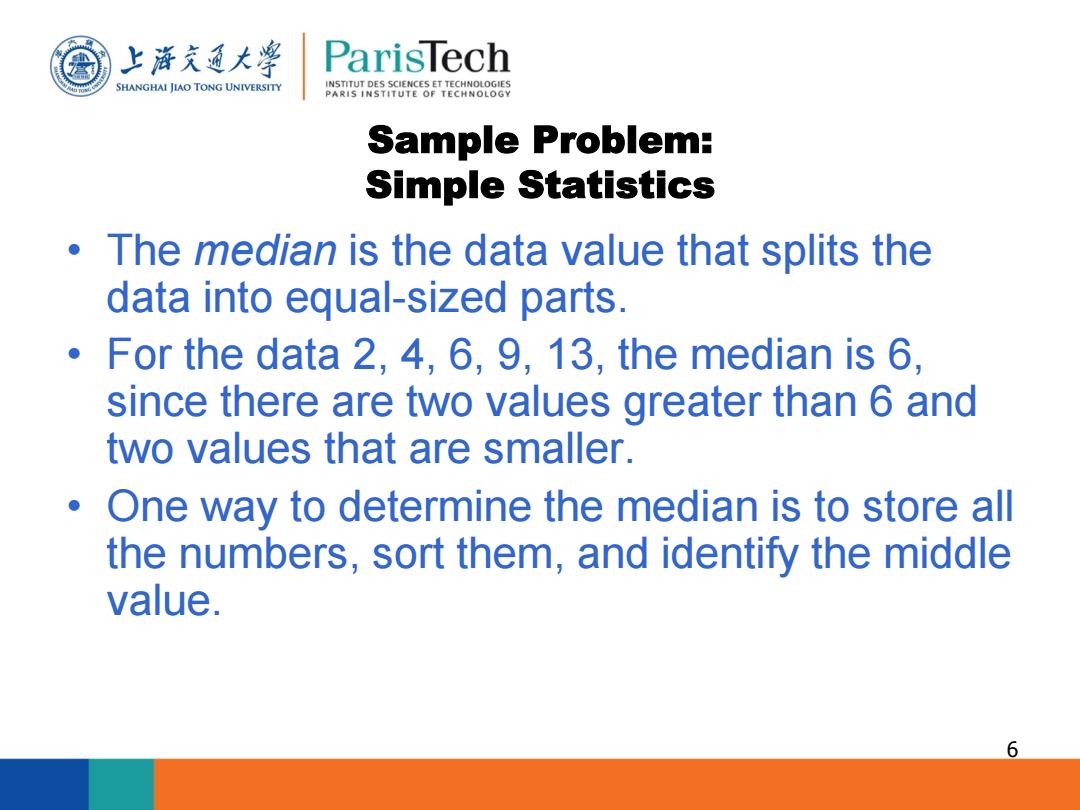
上游充通大 ParisTech SHANGHAI JIAO TONG UNIVERSITY INSTITUT DES SCIENCES ET TECHNOLOGIES PARIS INSTITUTE OF TECHNOLOGY Sample Problem: Simple Statistics The median is the data value that splits the data into equal-sized parts. For the data 2,4,6,9,13,the median is 6, since there are two values greater than 6 and two values that are smaller. One way to determine the median is to store all the numbers,sort them,and identify the middle value. 6
Sample Problem: Simple Statistics • The median is the data value that splits the data into equal-sized parts. • For the data 2, 4, 6, 9, 13, the median is 6, since there are two values greater than 6 and two values that are smaller. • One way to determine the median is to store all the numbers, sort them, and identify the middle value. 6
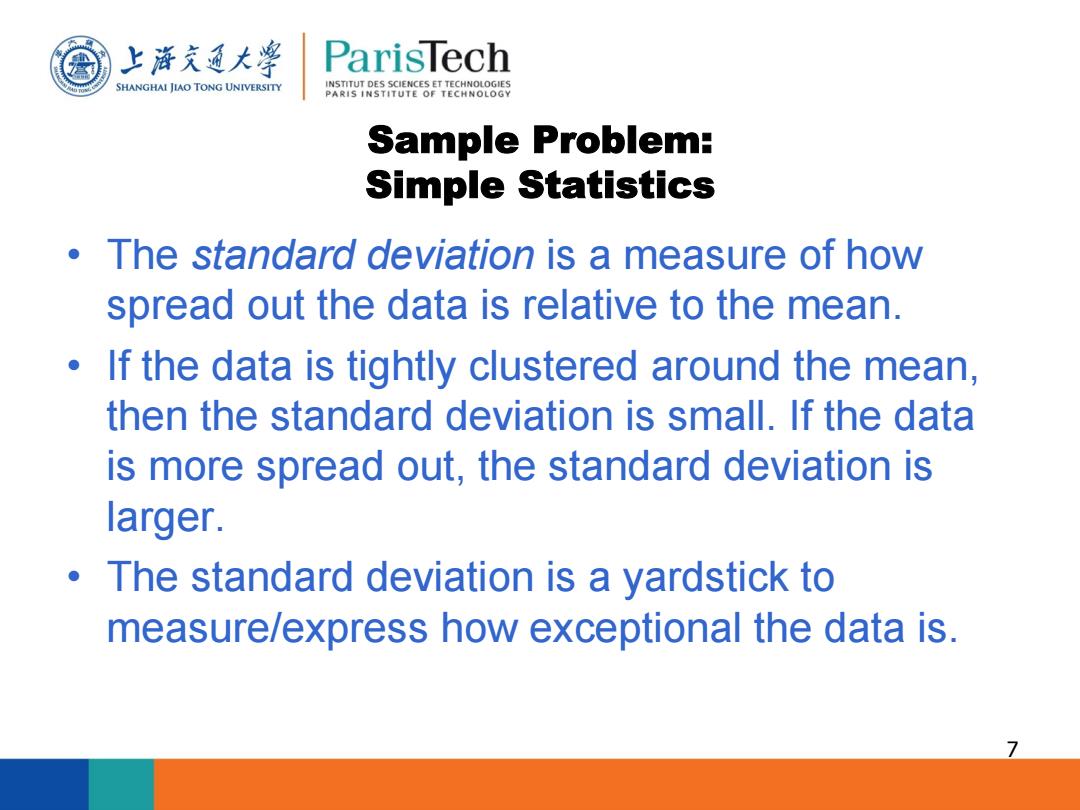
上游充通大 ParisTech SHANGHAI JIAO TONG UNIVERSITY INSTITUT DES SCIENCES ET TECHNOLOGIES PARIS INSTITUTE OF TECHNOLOGY Sample Problem: Simple Statistics The standard deviation is a measure of how spread out the data is relative to the mean. If the data is tightly clustered around the mean, then the standard deviation is small.If the data is more spread out,the standard deviation is larger. The standard deviation is a yardstick to measure/express how exceptional the data is. 7
Sample Problem: Simple Statistics • The standard deviation is a measure of how spread out the data is relative to the mean. • If the data is tightly clustered around the mean, then the standard deviation is small. If the data is more spread out, the standard deviation is larger. • The standard deviation is a yardstick to measure/express how exceptional the data is. 7
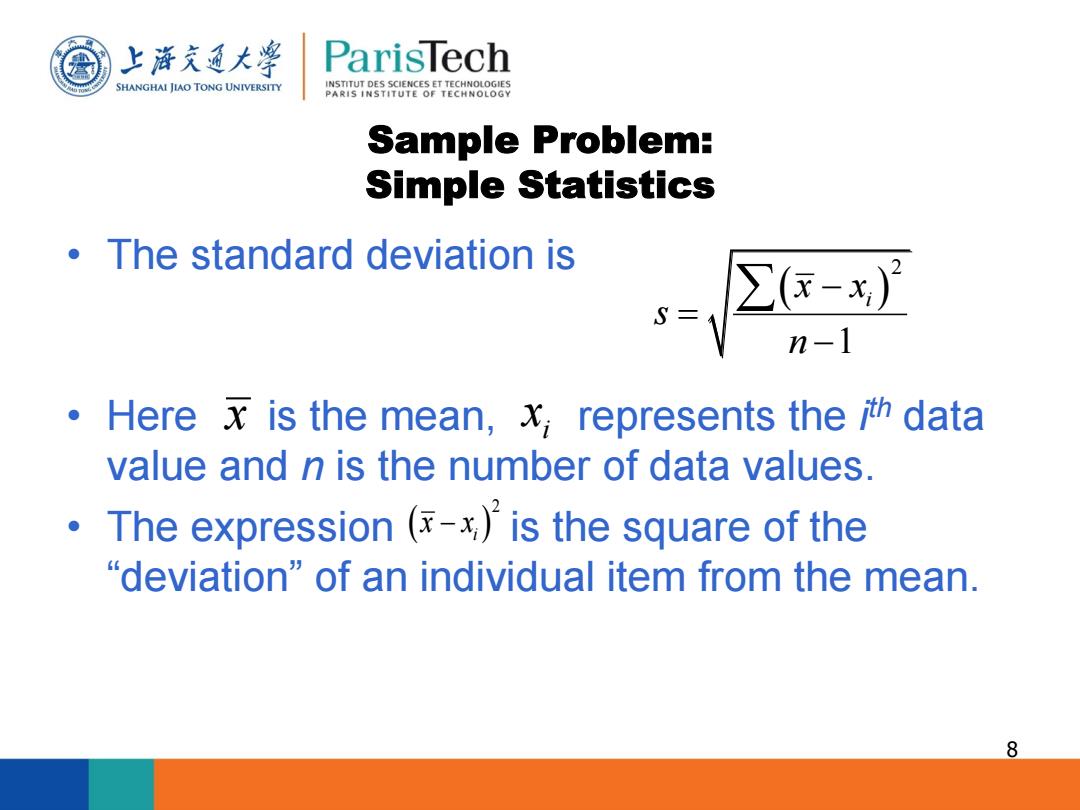
上游充通大 ParisTech SHANGHAI JIAO TONG UNIVERSITY INSTITUT DES SCIENCES ET TECHNOLOGIES PARIS INSTITUTE OF TECHNOLOGY Sample Problem: Simple Statistics The standard deviation is 2 Here x is the mean,x represents the ith data value and n is the number of data values. The expression (-x)is the square of the "deviation of an individual item from the mean. 8
Sample Problem: Simple Statistics • The standard deviation is • Here is the mean, represents the i th data value and n is the number of data values. • The expression is the square of the “deviation” of an individual item from the mean. 8 2 1 i x x s n x i x 2 i x x

上游充通大 ParisTech SHANGHAI JIAO TONG UNIVERSITY INSTITUT DES SCIENCES ET TECHNOLOGIES PARIS INSTITUTE OF TECHNOLOGY Sample Problem: Simple Statistics The numerator is the sum of these squared “deviations”across all the data. Suppose our data was 2,4,6,9,and 13. The mean is 6.8 The numerator of the standard deviation is (6.8-2)}+(6.8-4)2+(6.8-6)}2+(6.8-9)2+(6.8-13)°=149.6 s9574-61 9
Sample Problem: Simple Statistics • The numerator is the sum of these squared “deviations” across all the data. • Suppose our data was 2, 4, 6, 9, and 13. – The mean is 6.8 – The numerator of the standard deviation is 9 2 2 2 2 2 6.8 2 6.8 4 6.8 6 6.8 9 6.8 13 149.6 149.6 37.4 6.11 5 1 s
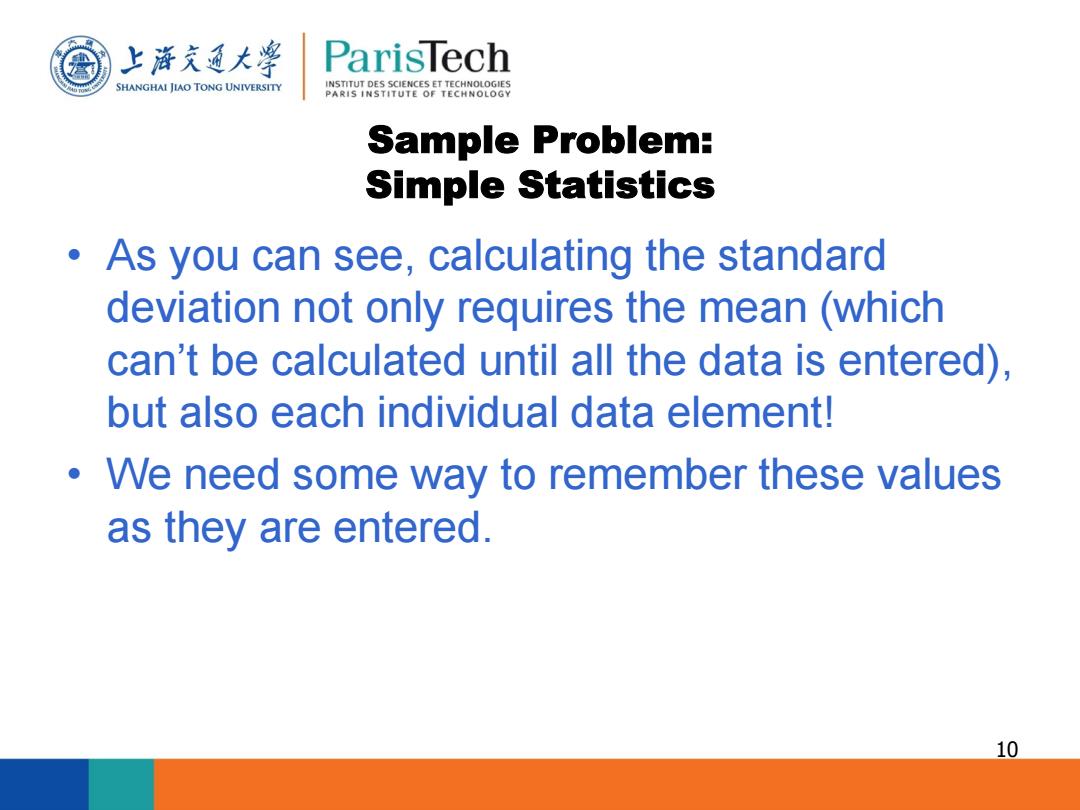
上游充通大 ParisTech SHANGHAI JIAO TONG UNIVERSITY INSTITUT DES SCIENCES ET TECHNOLOGIES PARIS INSTITUTE OF TECHNOLOGY Sample Problem: Simple Statistics As you can see,calculating the standard deviation not only requires the mean (which can't be calculated until all the data is entered), but also each individual data element! We need some way to remember these values as they are entered. 10
Sample Problem: Simple Statistics • As you can see, calculating the standard deviation not only requires the mean (which can‟t be calculated until all the data is entered), but also each individual data element! • We need some way to remember these values as they are entered. 10